Searching for the best network monitoring software to monitor the network flow of your device? We are reviewing the top network monitoring tool.
In the last few years, networking monitoring tools are in a state of constant growth. Today we have the best network monitor tools with the quality for Windows and Linux OS. And there is a demand for open-source network monitoring with network scanning, network monitoring and SNMP integration combined, which is good news for administrators. At present, many network monitoring tools provide a real-time breakdown of your live network.
Network monitoring is a place where you will find many tools. So we have found the best network monitoring software for you. Here you will find paid, free, and open-source software for Windows, Mac, and Linux OS.
In this article, we’ve prepared a list of the best network monitoring software on the market. Every tool listed here is suitable for the business environment. We have paid attention to various features and key differentiators like real-time network monitoring, notifications, alerts, visualization, custom configurations, and topology mapping.
Recommended: Best IT Help Desk Software

Best Network Monitoring Software of 2023
Contents
- 1 Best Network Monitoring Software of 2023
- 1.1 #1. Site24x7 Network Monitoring
- 1.2 #2. ManageEngine OpManager
- 1.3 #3. Obkio Network Performance Monitoring
- 1.4 #4. Checkmk
- 1.5 #5. SolarWinds
- 1.6 #6. Paessler PRTG Network Monitor
- 1.7 #7. Zabbix
- 1.8 #8. Nagios XI
- 1.9 #9. Icinga
- 1.10 #10. Spiceworks Network Monitor
- 1.11 #11. Advanced IP Scanner
- 1.12 #12. Logic Monitor
- 1.13 #13. EventSentry
#1. Site24x7 Network Monitoring
Website: https://www.site24x7.com/network-monitoring.html
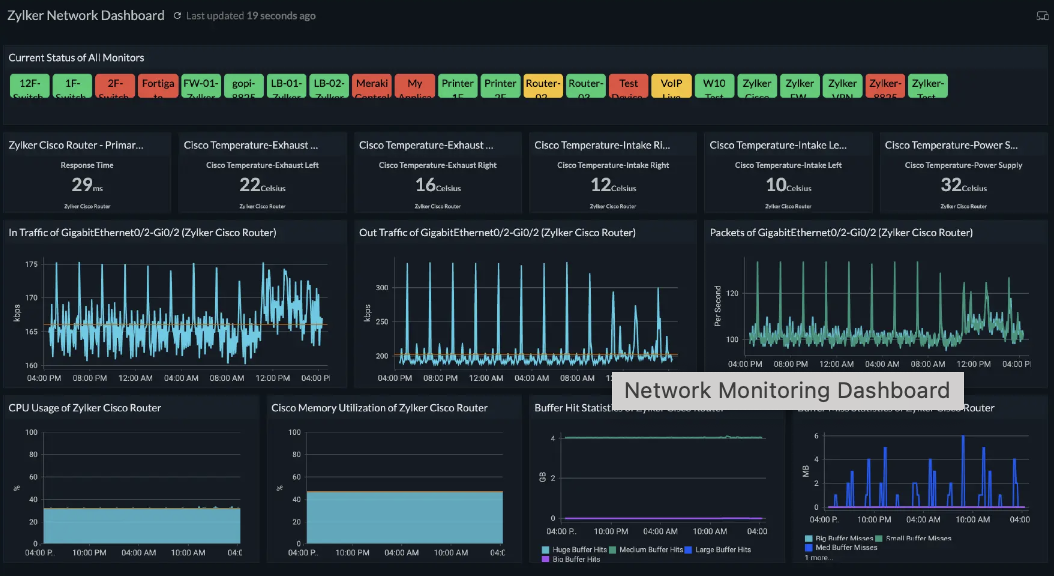
Site24x7 is an AI-powered, SaaS-based, full-stack monitoring solution from ManageEngine, a division of Zoho Corporation. Site24x7 offers network monitoring, NetFlow Analyzer, Network Configuration Manager (NCM), and Cisco Meraki monitoring. Upon detecting issues, Site24x7 sends instant alerts, which you can configure to be sent via SMS, emails, voice calls, push notifications, and RSS feeds. You can view data in tables, charts, graphs, dashboards, and reports and integrate with third-party apps like Slack, Microsoft Teams, and Jira.
Site24x7 makes network monitoring simple—even in complex networks—by offering complete visibility into your networks with deep insights at the device level and interface level. It also has a wide breadth of intuitive features, like automatic discovery and classification for over 10,000 device types with SNMP support; instant processing of SNMP traps for alert notifications; and visualizations of the network hierarchy and connections via topology and Layer 2 maps.
Site24x7’s NetFlow Analyzer helps you steer clear of network traffic blind spots. You can identify bandwidth hogs, fix them, and boost your network performance. Site24x7 tracks and analyzes flows based on technologies like NetFlow, J-Flow, and sFlow, also providing detailed stats and reports that you can use to fix issues quickly.
Site24x7’s NCM tool automatically detects all network configuration changes and makes backups of them. So even if there’s a network outage due to an unauthorized configuration change, all you have to do is restore an approved backup from the tool. Site24x7 supports protocols like SSH, SSH – SCP, SSH – TFTP, TELNET, and TELNET – TFTP.
Monitor your Cisco Meraki cloud controller to flag speed breakers and immediately get alerted about device downtime. Track the status, availability, health, and performance of devices using SNMP or REST APIs as required.
Site24x7’s easy deployment, easier maintenance, and peerless scope of coverage has fostered invaluable customer trust for over 15 years. With more breadth and depth in its network monitoring module than the average solution; a transparent pricing model; and a free, 30-day trial, Site24x7 is greatly preferred by organizations that require secure, comprehensive network monitoring.
#2. ManageEngine OpManager
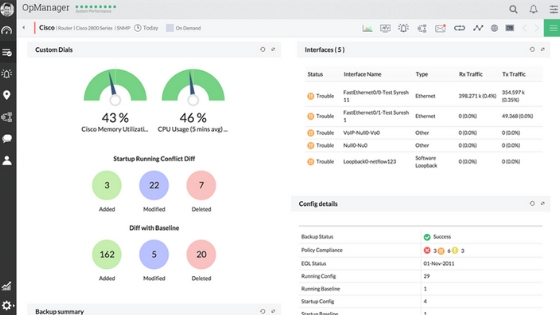
ManageEngine OpManager is a user-friendly network management solution used by over 1,000,000 IT Admins worldwide. With real-time monitoring, customizable dashboards for a network with servers, routers, switches, ports, WLCs, firewalls, LANs, and IPs. With the rule-based discovery, custom notification profiles, workflow automation, OpManager ensures your network is up and running 24/7. OpManager monitors VMware, Hyper-V, Xen, and Nutanix server environments. All this and seamless integration with other tools makes OpManager a single stop shop for network monitoring.
The greatest asset of OpManager is a visualization by which you can get a view, graphs, dials, charts, and color-coded availability via the dashboard. You can also create custom reports. The heart of OpManager’s functionality is customization. User-configurable notifications are part of this comprehensive design.
The scalability of this best network monitoring tool is such that it is suitable for any organization from small to large enterprises. For 10 devices the price is $245 for the essential edition, and for 250 devices the price is $11,545 for the enterprise edition. A free version for three devices, two users, with basic monitoring functionality is also available. You may check for a price quote.
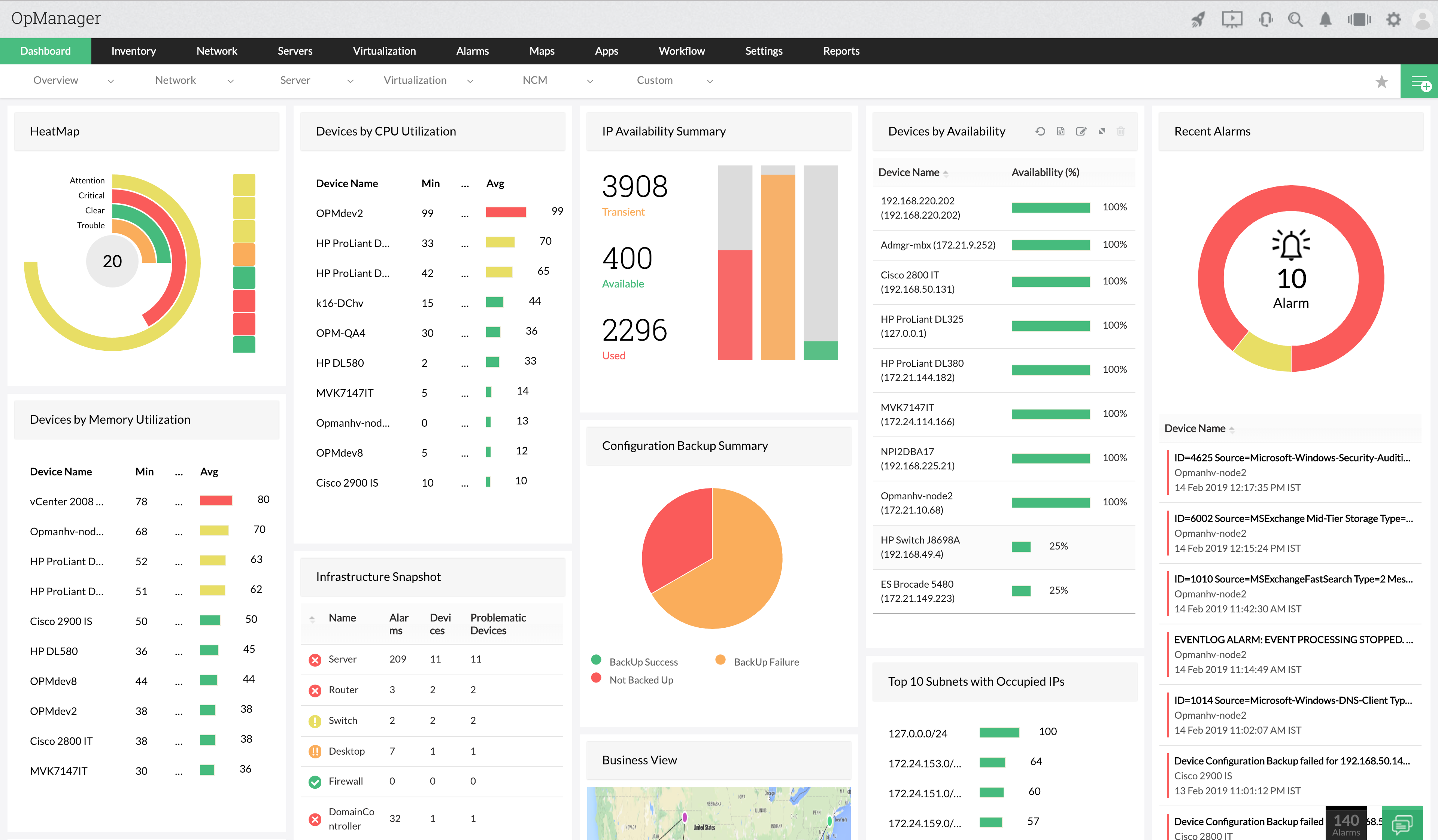
#3. Obkio Network Performance Monitoring
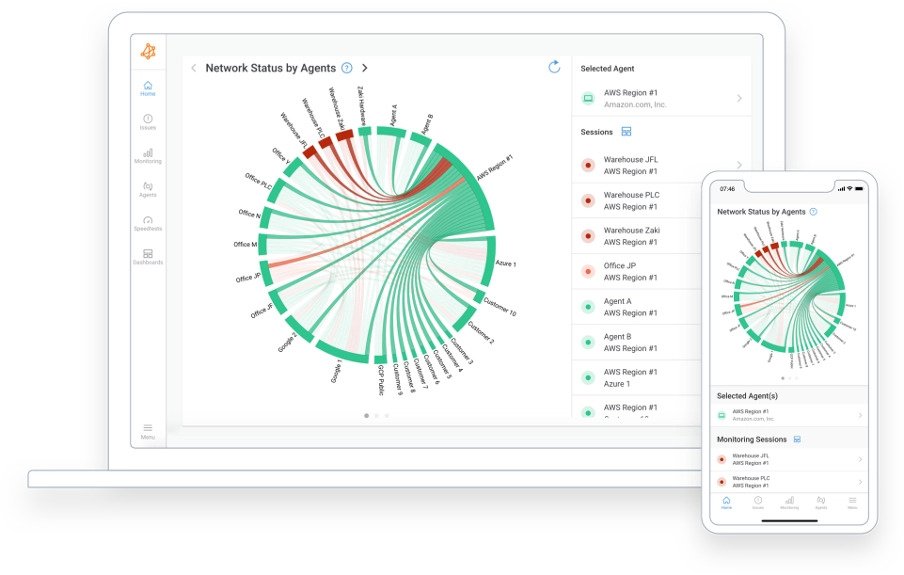
Obkio is the simplest network performance monitoring SaaS solution that empowers users with end-to-end visibility of the network performance. With quick and easy installation, users can start monitoring network performance within minutes, with access to Obkio’s sleek, user-friendly interface.
No one can afford network slowdowns – that’s why Obkio continuously monitors the health of network and core business applications to improve the end-user experience and identify the cause of intermittent network, VoIP, video, device, and applications slowdown in seconds.
Easily view all network alerts and metrics on Obkio’s customizable dashboard, complete with Obkio’s innovative chord diagram.
Obkio’s solution consists of deploying software or hardware network monitoring Agents at strategic locations in a company’s offices, branches and other network destinations to monitor network performance in a distributed, decentralized manner. It continuously measures network performance, collects data, and automatically alerts users of any network performance problems.
Obkio continuously tests and measures different operating parameters based on network metrics, such as latency, jitter, packet loss, quality of service and customer experience via the QoE (Quality of Experience) and performs speed tests regularly to check whether the data available coincides well with what should be offered by service providers.
With Obkio’s Network Device Monitoring solution, monitor the health of network devices such as Firewalls, Routers, Switches, Wi-Fi APs and any SNMP-enabled devices.
Try Obkio for free with a 14-day trial, with access to all of Obkio’s premium features. Users can also choose from a variety of free and paid plans tailored to their needs.
#4. Checkmk
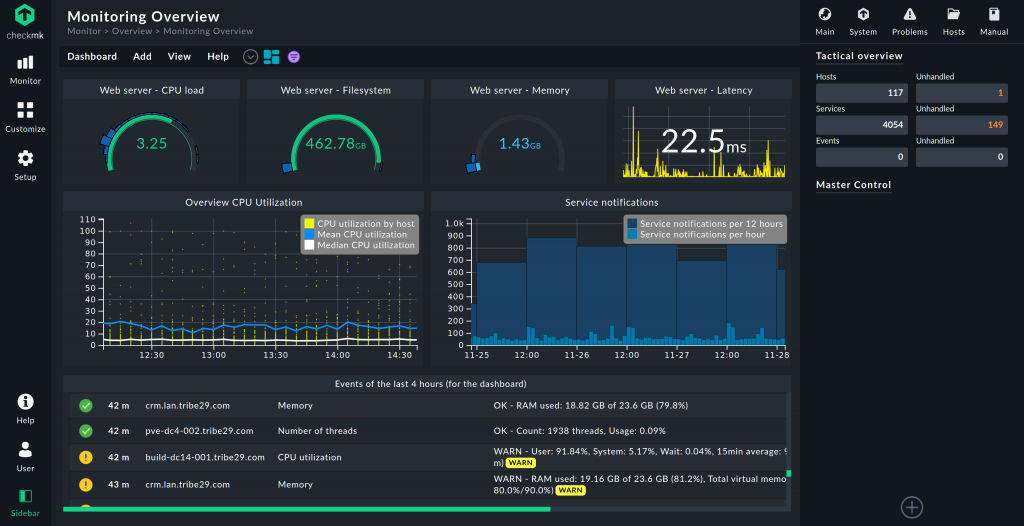
Checkmk is a universal monitoring tool with great capabilities for monitoring your network devices. The Checkmk Raw Edition is completely open-source and offers free and unlimited monitoring. The Checkmk Enterprise Edition comes with additional functionalities.
The tool supports monitoring via the Simple Network Management Protocol (SNMP), but it also comes with more than 1,900 preconfigured plug-ins for vendors such as Cisco, Brocade, Dell, Huawei, Intel, Juniper, TP-Link and many more. The integrations make the monitoring very efficient and allow you to track more assets with less hardware resources while getting more insights. One Checkmk instance can monitor thousands of devices and can easily scale horizontally thanks to the Checkmk distributed monitoring setup.
Due to the intelligent auto-discovery function, it takes you less than 15 minutes to set up a monitoring for your network. The graphical user interface of Checkmk makes managing your monitoring simple and allows you to create precise visualizations.
You can create high-level overviews or detailed network mappings with just a few clicks. You can also create individual dashboards and access rights for different users, for example, high-level overviews for the C level of your organization, or detailed insights into one device or segment for IT specialists working in the field. Checkmk also supports network flow monitoring, so you and your colleagues can see even more details, if necessary.
Thanks to the rule-based concept for configuring your monitoring, Checkmk is especially powerful when monitoring a large number of similar devices, in contrast to a template-based approach, in which you need to configure each ‘sensor’.
#5. SolarWinds
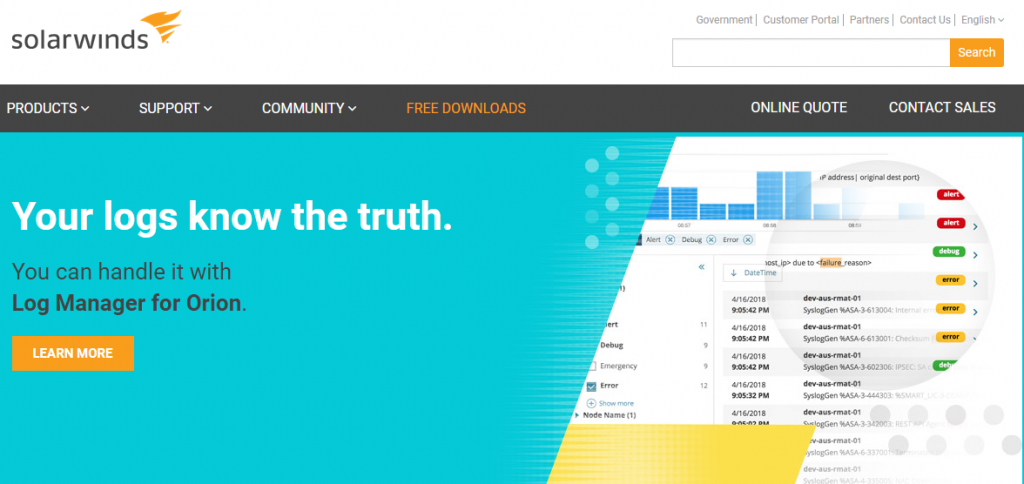
SolarWinds network monitoring software is the first name of our list. It is a top range software that tracks all of your network elements via the SNMP-Simple Network Management Protocol and a centralized dashboard. Whether you are running a wired or wireless network, you can use this network to find the signs of poor performance.
It is easy and effortless to use. SolarWinds gives you a diverse range of visual elements like maps, pie charts, and warnings for the network performance. For example, it highlights all the network element that has problems of Nodes with window. Or the Application Health Overview shows you the health of the overall section across your whole network.
The auto-discovery feature manually locates the devices on your network and outlines them to your system. So it saves the time that you spend on manually linking the network devices to the central device.
The comprehensive but straightforward design of SolarWinds is one of the plus points that makes it the best network monitor software. However, it has much more to offer like create customized alerts for network faults. Even you can allocate the alert to a specific person of the group with this software. It is useful in circumstances where you want to transfer the task to the team member. The reason why it is top of our list is it is a perfect blend of handiness and network monitoring. Another two stands out features are the auto-discovery feature and high-level visualization. It is available from $2,895 upwards. To check out the software, it gives you a 30-day free trial.
#6. Paessler PRTG Network Monitor
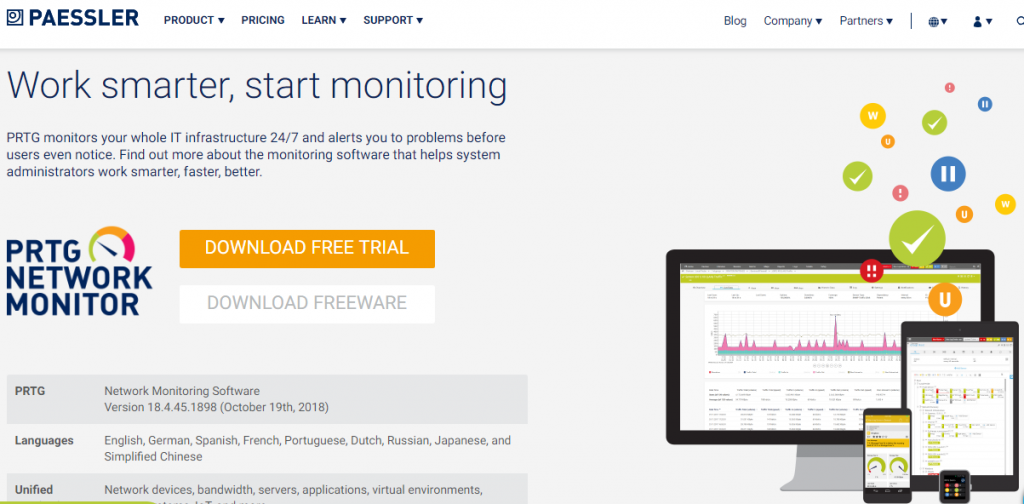
Paessler PRTGPRTG Network Monitor is another network management tool that gives you excellent monitoring features. PRTG uses Simple Network Management Protocol, packet sniffing, and Windows Management Instrumentation to monitor network devices.
However, it is simple to use. It also has its auto-discovery feature which works as a network mapper and identifies network elements without configuring them manually. It also reduces manual labor. Once you start using it from a pc or mobile, it starts monitoring your network via the PRTG app.
One of the first things that you notice is it is difficult to maintain the record; it is not clear. But it gives you sufficient information it has enough depth to give you a clear picture if you continue beyond the initial clunkiness and familiar with it.
PRTG maps offer visual offerings. And maps are used in many ways. The simplest way to create the map is to create a map and denote each device on your network. However, you can customize it and set it to show the most critical sensor of the network. You can also set automatic map rotation, and you can change the map view from 10 seconds to 10 minutes.
Though to use it, you have to get used to it, but it is perfect for the one who is new to network monitoring. With the learning curve, the additional features like auto-discovery, alerts, and visual displays make it better to use. It has some pricing options according to use. It can works on up to 100 monitors to the XL5 package for $1,400. The XL1 package gives you the best value for money by providing unlimited sensors for $13,436. It also provides you a trial version, and it remains free up to 100 Sensors.
#7. Zabbix
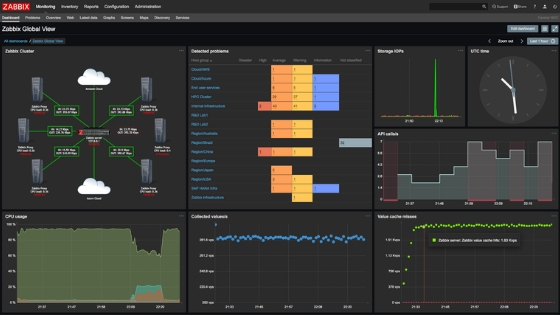
Zabbix is an open-source software that comes into action once you launch it. As you launch the GUI, you can see the user-friendly design of the software. You can access almost all web browsers like Mozilla Firefox, Microsoft Internet Explorer, and Google Chrome.
It works well on customization. The user configuration can send through email or SMS. Throughout your network, you can run scripts from the device or remotely. It is useful particularly when you need quick action like performance issues.
Zabbix uses SNMP and IMPI in combination to control your network. You can use it to look at the network bandwidth, network health, device utilization by memory or CPU, and configuration changes.
You will receive a message in the message window if there is any network issue with all of the detail. It is one of the network management tools which has an extensive range of templates to monitor devices. It has templates of companies like Intel, Dell, Netgear, Cisco, Huawei, and Nokia Networks devices. And all of the templates come with triggers, the scenario of the vendor device, default applications, and graphs.
Overall Zabbix is the best network monitoring software for medium to large businesses. It is available for free and accessed as a web interface. One can also download it for Red Hat Enterprise Linux, Linux, CentOS, Oracle, Ubuntu, and Debian.
#8. Nagios XI
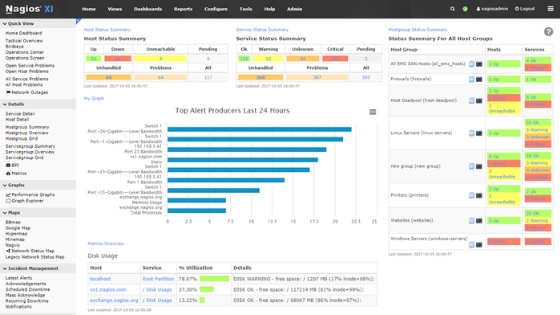
Nagios XI, a network monitoring software tool that is known for its wide demographic data. For those who want a low maintenance solution, it is best for them. It uses a web-based user interface which makes it more accessible. Configuration wizards set up your monitoring network as well as manage your service quickly.
The visualization of the software is extensive, including graphs and pie charts displaying network performance. It also has the capacity for planning graphs. With these graphs, you can plan your IT infrastructure for the future with long-term uptime and as per your needs.
multi-tenant access is a unique feature provided by Nagios XI. It let multi-user access to sections of network infrastructure and let the user see authorized devices. It is useful in large organizations where there are many staff members, and each has a different duty to handle. It operates on Redhat Enterprise Linux or CentOS. You will get the standard edition for $1,995 and the enterprise edition for $3,495. The free version is also available to monitoring seven nodes.
#9. Icinga
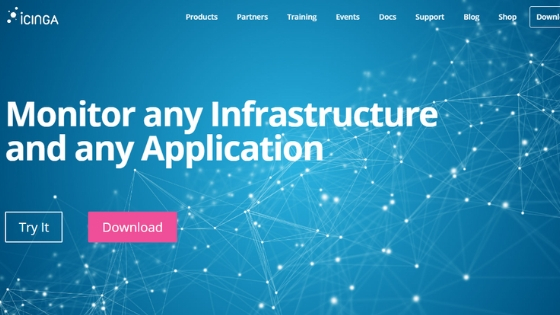
Icinga is another relatively well-known network monitoring software product. It uses direct monitoring and SNMP to gather all usage data from each device that is active on a system. The major processes conducted through the REST API. The entire user interface secured with SSL. It gives the power to the user to update their configurations and view information about existing problems. Many large companies use this product like Audi, Adobe, and Vodafone.
Icinga’s user interface is relatively clean. It is plugins that make a stand out Icinga. It provides you with many plugins that conduct various monitoring tasks. Even for Windows and Linux, they have unique plugins. You can also build your plugin also from scratch.
The alert system of the software notifies the user via SMS or test so that you can reach your environment even though you are not monitoring t directly. Icinga can segment the alerts and send them to a specific user only. In short, these network performance monitoring tools have all the specific and special features that a company needed for monitoring its network. It is free. And if you the REST API complex, then there are abundant manuals available to help you.
#10. Spiceworks Network Monitor
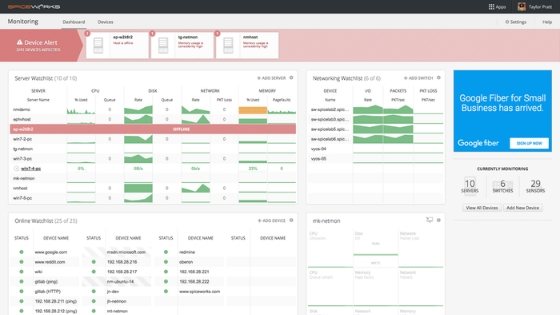
Spiceworks has developed its name b self as it is the best network management software available today. It monitors and gives real-time data of your network through SNMP. Even if you are a new user, then also you will find installation easy, but it takes your time as it is the initial process of setting up. Once you are done with the setup, you will have a shortcut for the web GUI.
The network maintains a user-friendly design; there is the main dashboard which can be customized. Network Monitor supports color-coded graphs to display the data in an understandable form. From your home screen, you can monitor all your main device.
User configured alerts are another feature where the user can set alert parameters to notify by email or SMS. One can also set the individual alert, but it is said that custom alerts are not advisable as it has higher chances of error. It has an advertisement which is the main limitation of it.
It is the first choice for organizations of all sizes. It supports all versions of Windows. What you need is the download the software on your device.
#11. Advanced IP Scanner
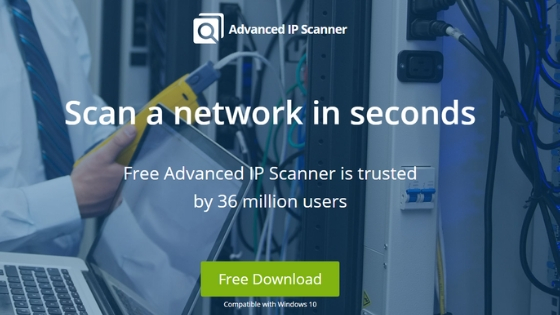
Advanced IP Scanner has about 30 million users worldwide, and the number of users is enough to say that it is one of the top network management software. It uses LAN environments and lets you monitor your network. Many other features like the ability to switch computers on and off remotely, Mac address detection, etc. that make this software popular.
Advanced IP Scanner is swift and lightweight. Within the user-defined range, it scans all IP addresses. Network devices identified automatically, and you can find they are active or not. You save the favorite devices and look them in privacy. Thus IP Scanner is suitable for all companies.
It is easy to use and if you don’t want to define the Ip range, then don’t do it. What you have to do is click on the scan option and the program will start scanning the device of your network and report you. To get more information, right-click on the device.
The major limitation of the Advanced IP Scanners is the user interface. Though it is easy to use yet, it does not have a modern GUI. You can’t create graphs or other visuals, but you can export the scan documents in CSV format.
At last with the limitations, Advanced IP Scanner can work with high-level enterprise environments. And it is entirely free to use.
#12. Logic Monitor
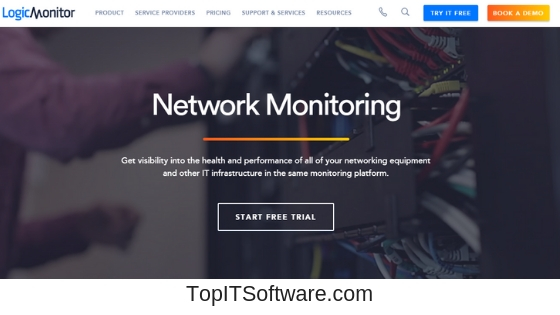
Logic Monitor is an excellent top network monitoring tools, and once you start using it, you can feel it. It automatically discovers devices on your network and collects information about it. Ease of use is another great thing about the software. There are approx. 1000 Logic Modules that automate monitoring and alerts and help the user. Ou can monitor AWS, Azure, apps, servers, and websites from one interface.
Logic Monitor has a lot to offer regarding visualization. You can transfer the data network and display it into color-coded graphs. By one graph, you can view multiple devices. Overall infrastructure, performance, and health display on the main dashboard.
One interesting feature is built-in forecasting like in the left bottom of the image above; you can see the graphs that show you disk usage forecasting. It shows you how much disk can expect to the usage in the future.
For Logic Monitor, there are pricing options also available and named Starter, Pro, and Enterprise. The Starter version includes alerting, dashboards, and reporting with a data retention period of three months, alert history storage of three months and ten services of web service checks. The Enterprise version has all the above features for two years and a service check for 300 services with 24×7 support. For the license version, you have to request a quote. It provides you with a free trial of 14 days.
#13. EventSentry
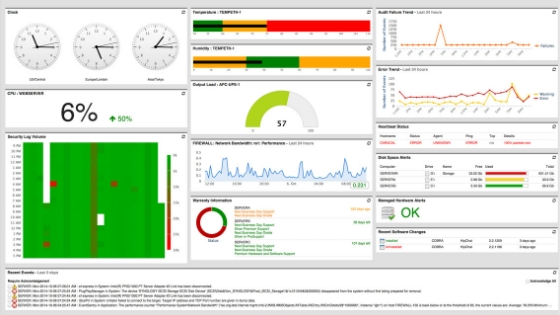
Over the past few years, EventSentry gaining attraction. Regarding action, it is limited to Windows devices. It takes approximately 30 minutes to set up and run. To run it, you don’t have to complete the configuration, and it does not make it inconvenient. The new version lets the user measure bandwidth utilization and views NetFlow data. It easily identifies the connection and its health.
All of your network data is converted to charts and graphs by visual displays and a geographical location, you can map network traffic also. All these graphs and displays identify the live network activity from a snapshot instead of the navigation tree.
For larger enterprises, it supports scheduled reporting. After generating the report, it automatically sends emails to key users. It means once the network finds an error, you can send the report to your team member immediately so that they can help to find a solution.
EventSentry also has pricing options for NetFlow Licenses, full licenses to Network Device Licenses. Pricing of a Full license is $85 per year, per Windows device, for 100 licenses $4698 and for 1000 devices $28998. It also provides a 30-day free trial.
Conclusion:
It is all about network monitoring software comparison. We hope you find it useful and informative. So before you pick any of the software, try a trial version and choose accordingly. Thank you for reading and staying connected with Top IT Software.
Jitendra Dabhi is content marketer since last 10 years. He is very much interested in writing about technology, software reviews and cybersecurity. He is featured in Entrepreneur.com, HackerNoon.com, ReadWrite.com, TemplateMonster, Tech.co, Tweakyourbiz, YourStory.com, freelancer.com etc.